�
Learning GraphQL
Declarative Data Fetching for Modern Web Apps
Eve Porcello and Alex Banks
Learning GraphQL
by Eve Porcello and Alex Banks
Copyright © 2018 Eve Porcello and Alex Banks. All rights reserved.
Printed in the United States of America.
Published by O’Reilly Media, Inc., 1005 Gravenstein Highway North,
Sebastopol, CA 95472.
O’Reilly books may be purchased for educational, business, or sales promotional
use. Online editions are also available for most titles (http://oreilly.com/safari).
For more information, contact our corporate/institutional sales department: 800-
998-9938 or corporate@oreilly.com.
Acquisitions Editor: Mary Treseler
Development Editor: Alicia Young
Production Editor: Justin Billing
Copyeditor: Chris Edwards
Proofreader: Octal Publishing, Inc.
Indexer: WordCo, Inc.
Interior Designer: David Futato
Cover Designer: Karen Montgomery
Illustrator: Melanie Yarbrough
August 2018: First Edition
�
Revision History for the First Edition
2018-08-08: First Release
See http://oreilly.com/catalog/errata.csp?isbn=9781492030713 for release
details.
The O’Reilly logo is a registered trademark of O’Reilly Media, Inc. Learning
GraphQL, the cover image, and related trade dress are trademarks of O’Reilly
Media, Inc.
The views expressed in this work are those of the authors, and do not represent
the publisher’s views. While the publisher and the authors have used good faith
efforts to ensure that the information and instructions contained in this work are
accurate, the publisher and the authors disclaim all responsibility for errors or
omissions, including without limitation responsibility for damages resulting
from the use of or reliance on this work. Use of the information and instructions
contained in this work is at your own risk. If any code samples or other
technology this work contains or describes is subject to open source licenses or
the intellectual property rights of others, it is your responsibility to ensure that
your use thereof complies with such licenses and/or rights.
978-1-492-03071-3
[LSI]
�
Preface
�
Acknowledgments
This book would not be a book without the help of many phenomenal people. It
started with the idea from Ally MacDonald, our editor for Learning React, who
encouraged us to write Learning GraphQL. We were then very lucky to get to
work with Alicia Young, who shepherded the book to its printing. Thanks to
Justin Billing, Melanie Yarbrough, and Chris Edwards who sanded off all of the
rough edges during an extremely thorough production edit.
Throughout the process, we were fortunate to get feedback from Peggy Rayzis
and Sashko Stubailo from the Apollo team who shared their insights and hot tips
about the latest features. Thanks also to Adam Rackis, Garrett McCullough, and
Shivi Singh, who were excellent technical editors.
We wrote this book about GraphQL because we love GraphQL. We think you
will too.
�
Conventions Used in This Book
The following typographical conventions are used in this book:
Italic
Indicates new terms, URLs, email addresses, filenames, and file extensions.
Constant width
Used for program listings, as well as within paragraphs to refer to program
elements such as variable or function names, databases, data types,
environment variables, statements, and keywords.
Constant width bold
Shows commands or other text that should be typed literally by the user.
Constant width italic
Shows text that should be replaced with user-supplied values or by values
determined by context.
This element signifies a tip or suggestion.
TIP
NOTE
This element signifies a general note.
This element indicates a warning or caution.
WARNING
�
Using Code Examples
Supplemental material (code examples, exercises, etc.) is available for download
at https://github.com/moonhighway/learning-graphql/.
This book is here to help you get your job done. In general, if example code is
offered with this book, you may use it in your programs and documentation. You
do not need to contact us for permission unless you’re reproducing a significant
portion of the code. For example, writing a program that uses several chunks of
code from this book does not require permission. Selling or distributing a CD-
ROM of examples from O’Reilly books does require permission. Answering a
question by citing this book and quoting example code does not require
permission. Incorporating a significant amount of example code from this book
into your product’s documentation does require permission.
We appreciate, but do not require, attribution. An attribution usually includes the
title, author, publisher, and ISBN. For example: “Learning GraphQL by Eve
Porcello and Alex Banks (O’Reilly). Copyright 2018 Eve Porcello and Alex
Banks, 978-1-492-03071-3.”
If you feel your use of code examples falls outside fair use or the permission
given above, feel free to contact us at permissions@oreilly.com.
�
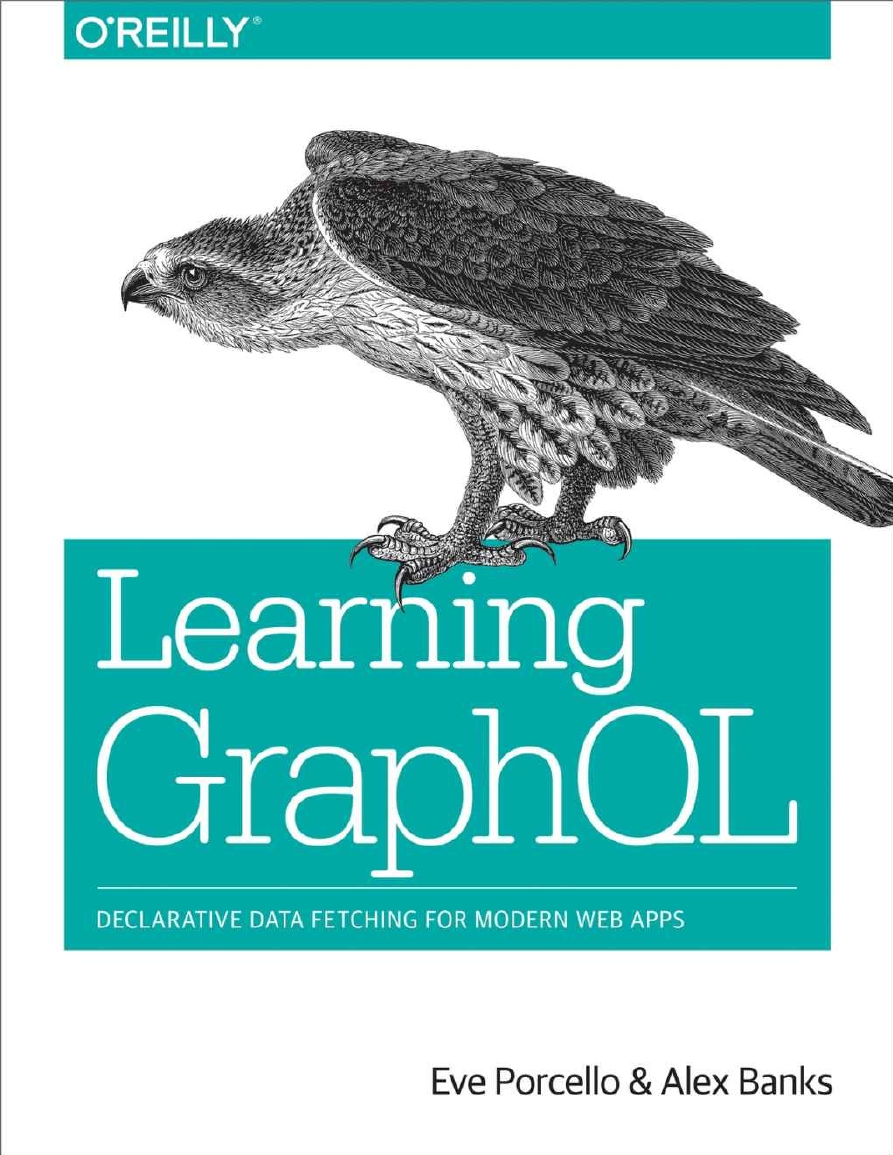
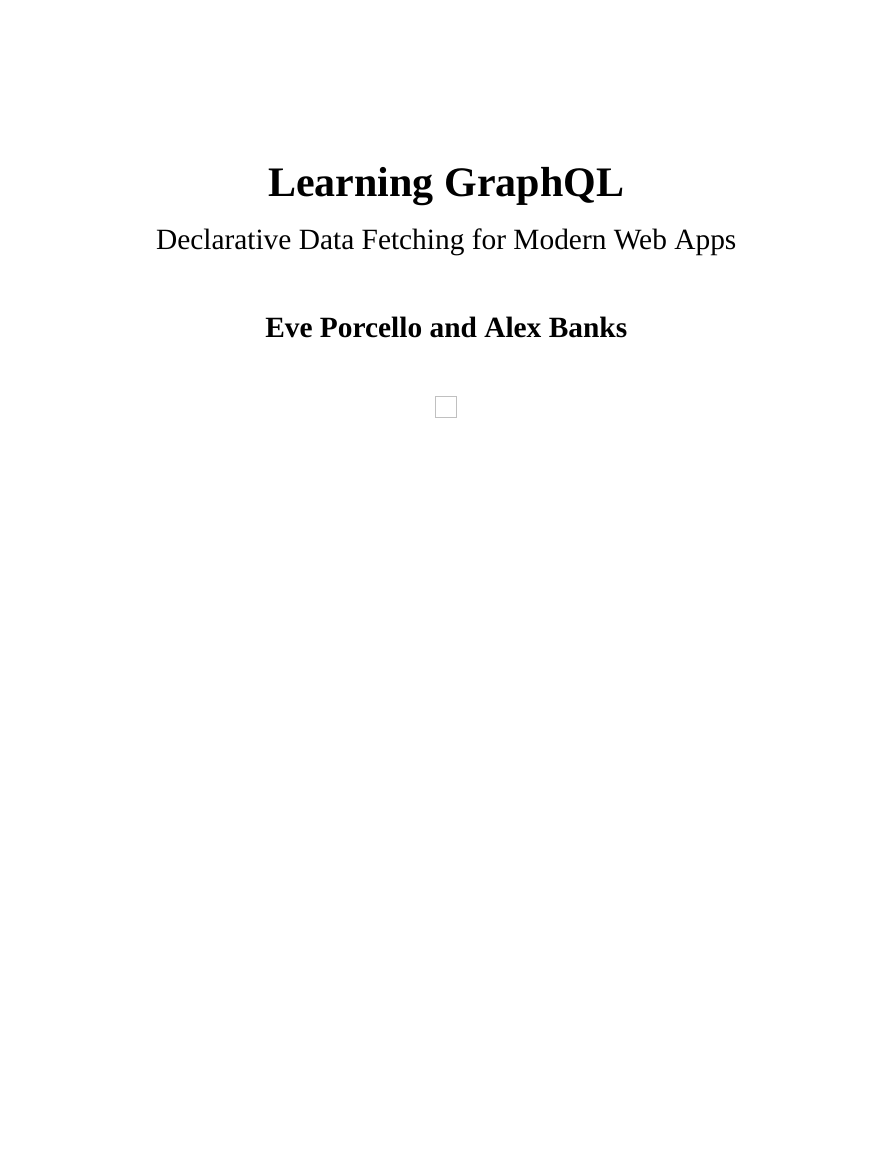
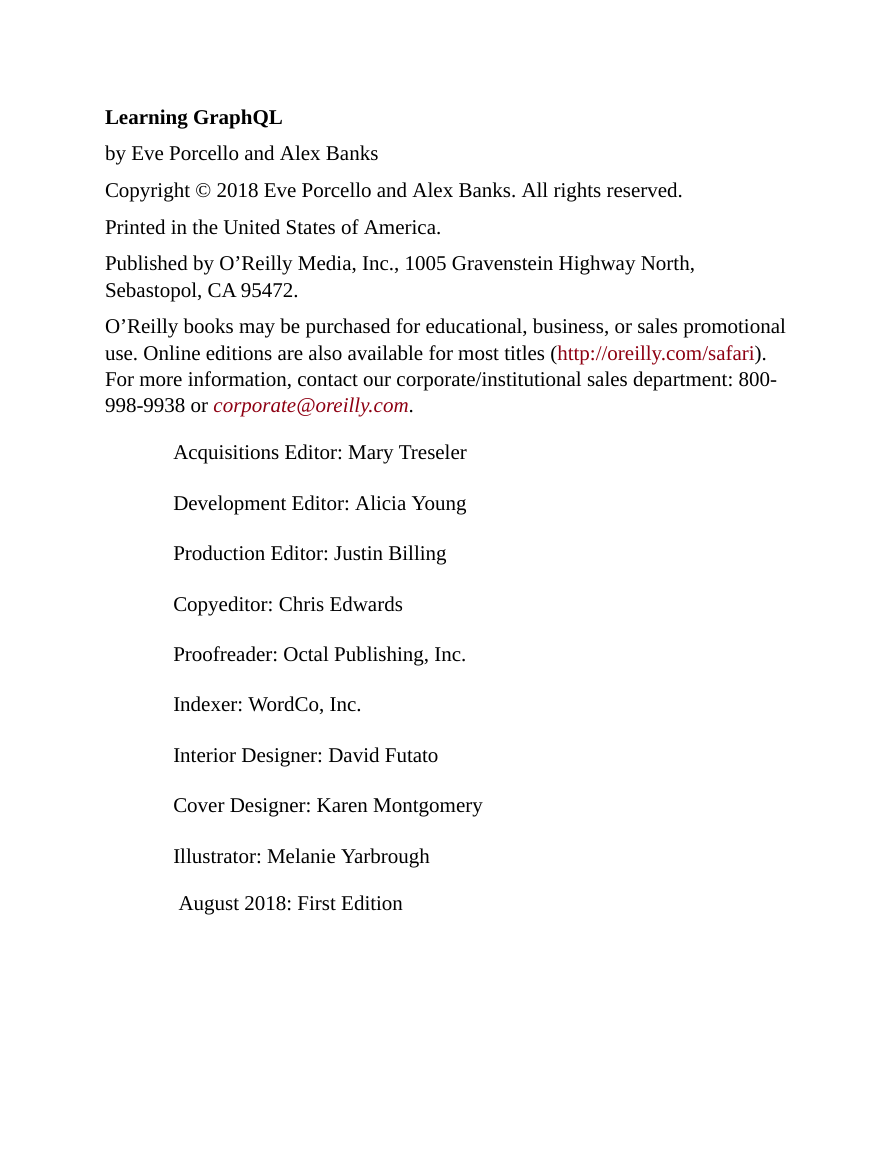


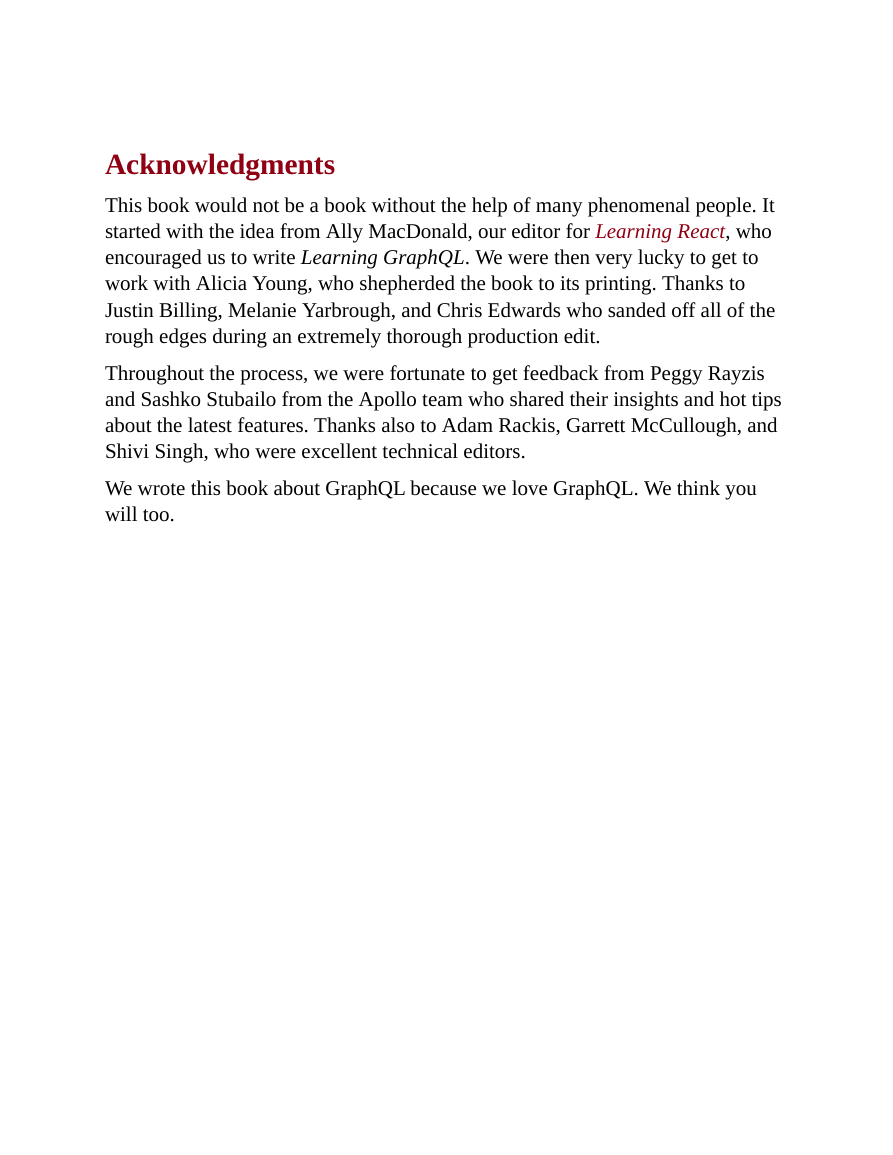

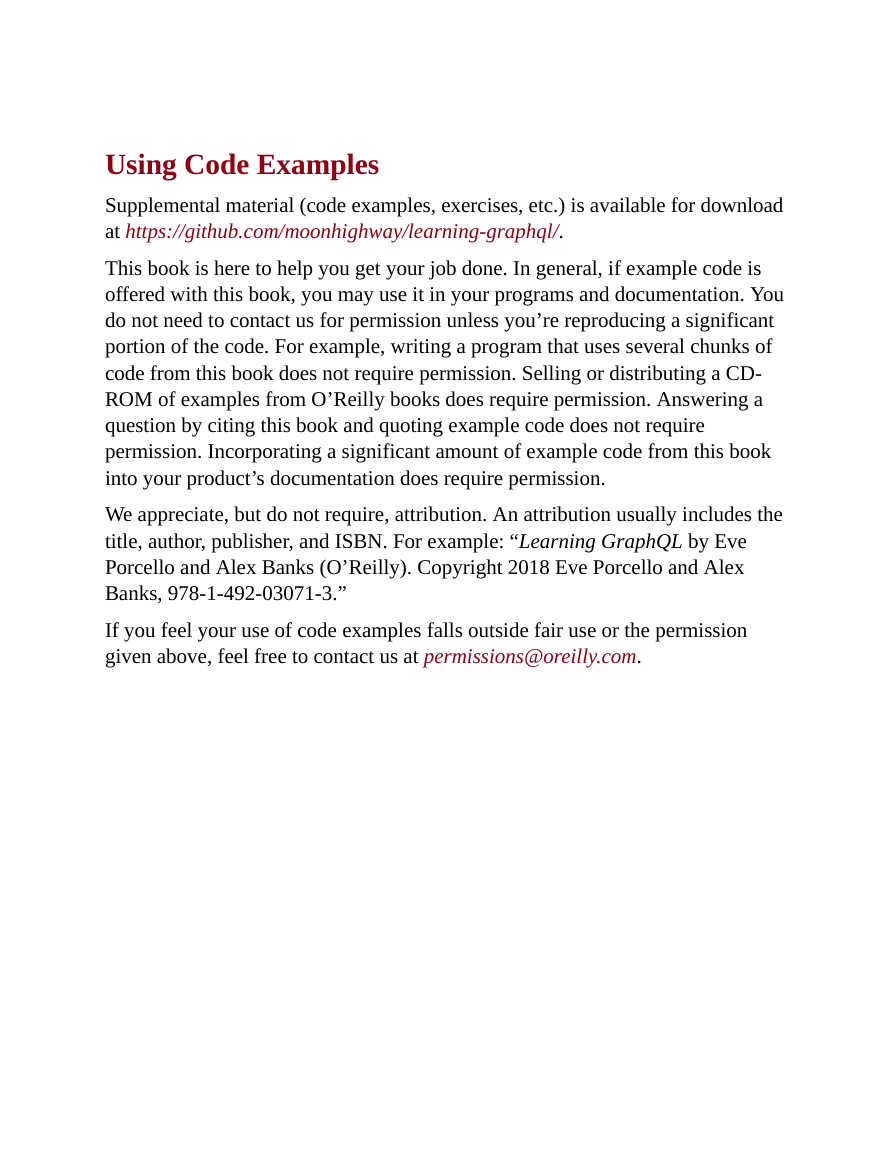








 2023年江西萍乡中考道德与法治真题及答案.doc
2023年江西萍乡中考道德与法治真题及答案.doc 2012年重庆南川中考生物真题及答案.doc
2012年重庆南川中考生物真题及答案.doc 2013年江西师范大学地理学综合及文艺理论基础考研真题.doc
2013年江西师范大学地理学综合及文艺理论基础考研真题.doc 2020年四川甘孜小升初语文真题及答案I卷.doc
2020年四川甘孜小升初语文真题及答案I卷.doc 2020年注册岩土工程师专业基础考试真题及答案.doc
2020年注册岩土工程师专业基础考试真题及答案.doc 2023-2024学年福建省厦门市九年级上学期数学月考试题及答案.doc
2023-2024学年福建省厦门市九年级上学期数学月考试题及答案.doc 2021-2022学年辽宁省沈阳市大东区九年级上学期语文期末试题及答案.doc
2021-2022学年辽宁省沈阳市大东区九年级上学期语文期末试题及答案.doc 2022-2023学年北京东城区初三第一学期物理期末试卷及答案.doc
2022-2023学年北京东城区初三第一学期物理期末试卷及答案.doc 2018上半年江西教师资格初中地理学科知识与教学能力真题及答案.doc
2018上半年江西教师资格初中地理学科知识与教学能力真题及答案.doc 2012年河北国家公务员申论考试真题及答案-省级.doc
2012年河北国家公务员申论考试真题及答案-省级.doc 2020-2021学年江苏省扬州市江都区邵樊片九年级上学期数学第一次质量检测试题及答案.doc
2020-2021学年江苏省扬州市江都区邵樊片九年级上学期数学第一次质量检测试题及答案.doc 2022下半年黑龙江教师资格证中学综合素质真题及答案.doc
2022下半年黑龙江教师资格证中学综合素质真题及答案.doc